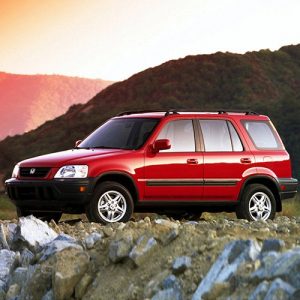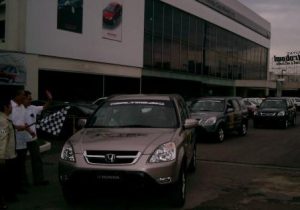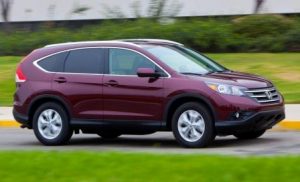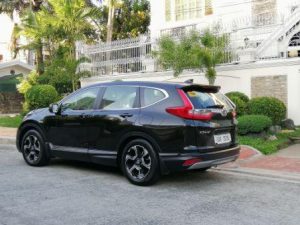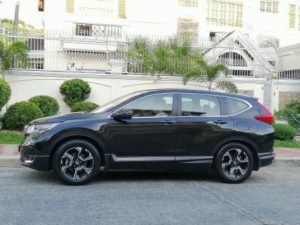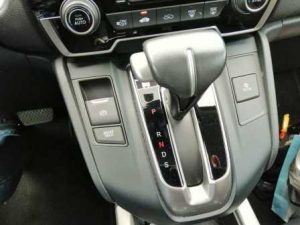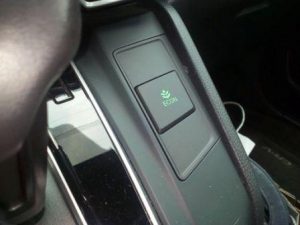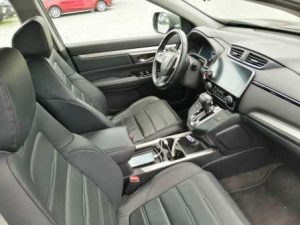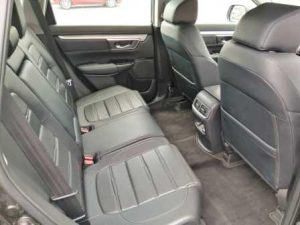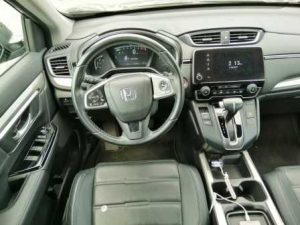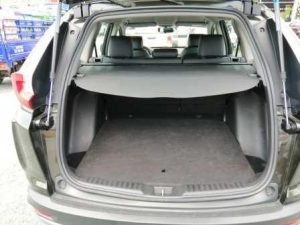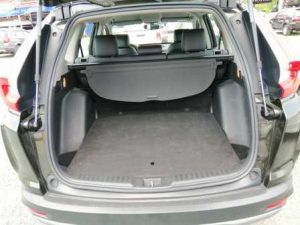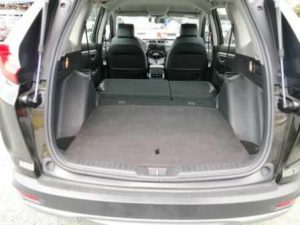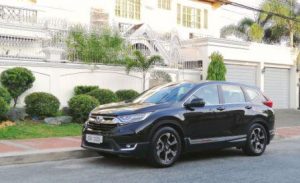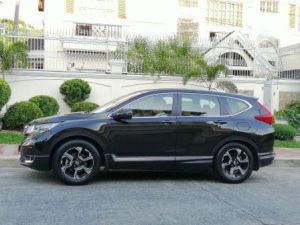While driving the latest iteration of the Honda CR-V, I was reminded of my long association with Honda Cars Philippines, Inc. (HCPI) as a motoring journalist. You see, one of my first test drives was that of a first generation CR-V, which was introduced in 1995. The second generation CR-V was introduced in 2002 and I was one of the local journalists invited by HCPI to the “CR-V Peak Drive” to the highest point in Luzon. The third generation bowed in 2006 while the fourth iteration debuted in 2012. The one I’m driving, a fifth generation CR-V, was launched in 2017 but it was its diesel-powered 7-seater variant that hogged the motoring pages of local publications.
For those who do not know, the CR-V mates a sport utility vehicles (SUV) body with a Honda Civic platform to become the company’s mid-range crossover SUV, slotting between the smaller Honda HR-V and the larger Honda Pilot. Depending on where it is marketed, Honda coined the term “CR-V” for “Comfortable Runabout Vehicle” in the Asian and American markets while quoting “Compact Recreational Vehicle” in British and European markets. In the Philippines, the Honda CR-V wetted the buyers’ appetite for compact sporty SUVs that could fit the average Filipino family while fitting through the tight and small streets.
We Got The Base
The latest CR-V is available as a gasoline-powered 5-seater or a diesel-powered 7-seater with a 9-speed automatic transmission and three model trims – the top-of-the-line SX Diesel 9AT with all-wheel-drive (AWD), the luxurious S Diesel 9AT, and the base model V Diesel 9AT, both with front-wheel-drive (FWD). For our “Driven” test drive story, we were lent a Dark Olive Metallic Honda CR-V 2.0 S CVT powered by a 1,999cc inline four-cylinder gasoline engine fitted with i-VTEC, Honda’s intelligent variable valve timing with electronic control, and, as the label suggests, a continuously variable transmission (CVT). It surely transported me back to my first time behind the wheel of a gasoline-powered CR-V.
Like the earlier CR-Vs, our “base model” test drive unit does the job quite well, transporting its occupants from Point A to Point B comfortably and reliably. Of course, the definition of “comfort” has changed since the early 2000s with automatic air-conditioning and connectibility becoming a big part of the buyers’ consideration as much as seating, legroom and headroom. Additionally, our CR-V 2.0 S sports 18-inch wheels, chrome garnishing, LED daytime running lights, full LED headlamps and taillights, shark’s fin antenna, and a deep metallic paint that erases any notion that it is a “base model”.
Under The Hood
Despite the “base model” classification, our CR-V 2.0 S has a lot of high-tech stuff under the hood. Its 2.0-liter i-VTEC engine has the aforementioned electronically-controlled intelligent variable valve timing system and an advanced electronic fuel injection that churns out more-than-adequate power with thrifty real-world fuel economy and environment-friendly emissions. The CVT automatically selects the right gear for the driving situation almost seamlessly while the paddle shifters are ready to hold the gear at the driver’s command.
Since we drove it around the metropolis with the frustratingly slow and crawling traffic, we decided to leave the CVT in full automatic mode. We were not able to fully experience our CR-V 2.0 S’ 154 horsepower and 189 Newton-meters of torque, but we managed to drive around for a whole week without refilling the fuel tank. We realized that having that “ECON” drive indicator lighting up while driving economically is far better than watching the tachometer rev up to its redline. Yes, the CR-V is based on the racier Civic but it’s also a family-oriented SUV, so we drove it as any family patriarch would. We were often passed by some faster drivers but we often passed them when they had to stop for gas. Ha!
Inside Is Where It Counts
After almost two decades of writing about cars, I’ve come to the age where I appreciate the interior more than other features. After all, this where everybody spends more time in any vehicle, especially if you drive around for hours going to a nearby destination, thanks to Metro Manila’s horrendous traffic situation. Inside the CR-V 2.0 S, the first thing you’ll notice is that it is anything but a “base model”. The seats and the dash are ergonomic and well designed. The controls are within easy reach, especially the high-mounted CVT shifter. The instruments are very legible, and the driving position is very comfortable for long shifts at the wheel.
Convenience features like the electronic parking brake with hold function, auto-leveling headlights, and the blind spot monitor that eliminates blind spots by showing the right-side lanes when the right turn signal is activated or the button at the tip of the left stick is pressed. The head unit with its seven-inch display monitor is like easy to operate and connect to your gadget using Bluetooth or USB. As a 5-seater, our CR-V 2.0 S has plenty of legroom and a large cargo compartment at the back. A removable trunk cover hides stuff at the back from prying eyes.
Ideal Metropolitan Crossover
Of course, the CR-V is not without fault. Our test unit has traveled nearly 15,000 kilometers, mostly with different drivers since it is a media car. The accelerator and brakes are a bit sensitive to the touch that some abrupt inputs may result in a less-than-smooth drive while the steering feels a bit too isolated from the road. But once you adjust to it, the CR-V 2.0 S will reward you with a pleasant, comfortable ride that can swallow all the road undulations that Metro Manila can throw at it.

With the trunk cover removed and one seat back folded, long items can be carried along with a passenger.
As far as a gasoline-powered car-based crossover SUV goes, our CR-V 2.0 S is almost economical. While it may not have the fuel mileage of its oil-burning stable mates, we were able to register 7.5 kilometers per liter driving around the traffic-snarled city and around 14.2 km/L when we drove it off-hours when traffic was unusually light. That we were able to drive it around for a week without consuming all the fuel in its 57-liter tank is one for the books. Or our books, at least.
At P1,658,000, the CR-V 2.0 S represents a lot of value for the money, as it was with the first-generation CR-V that I test drove in 2001. My wife Shawie, my then 1-year-old daughter Vette, and I found the first generation CR-V ideal for our small family. Years later, my family has grown and so has the CR-V. Still, my wife, my now 19-year-old daughter, my tall 13-year-old son Chevy, and I find the 2019 Honda CR-V 2.0 S CVT an ideal family car. Although, like it was eighteen years ago, my finances still cannot afford me a brand-new CR-V. I guess the more things change, the more they remain the same. And that’s a good thing!
SPECIFICATIONS
Vehicle Type : Front-engine, FWD, 5-door Crossover SUV
Price : P1,658,000.00
Engine : Liquid-cooled inline-4 i-VTEC
Displacement : 1,999cc
Transmission : CVT (7-speed paddle shifter)
Power : 154hp@6500rpm
Torque : 189Nm@4300rpm
Wheelbase : 2660 mm
Length : 4571 mm
Width : 1855 mm
Height : 1657 mm
Curb Weight : 2500 kg
Fuel Tank Capacity : 57 liters
Front Suspension : Independent, McPherson type
Rear Suspension : Independent, Torsion beam
Front Brakes : Ventilated discs
Rear Brakes : Discs
Steering System : Rack and pinion
Power Assistance : Electric (EPS)
Tires : 235/60R-18
Best Fuel Mileage : 7.5 km/liter (as tested)
Ave. Fuel Mileage : 7-8 km/liter (recorded)
CONTACT DETAILS
Honda Cars Philippines, Inc. (HCPI)
Sta. Rosa Plant and Head Office
105 South Main Avenue, Laguna Technopark Sta. Rosa, Laguna 4026 Philippines
Metro Manila Office
30/F, The Trade & Financial Tower, 7th Avenue corner 32nd Street, Bonifacio Global City, Taguig 1634 Philippines
Contact Numbers
Tel: (632) 857-7200 to 19 / 1-800-1000-HONDA / 857-7240
Fax: (632) 857-7288
 Power Wheels Magazine A Notch Above
Power Wheels Magazine A Notch Above


